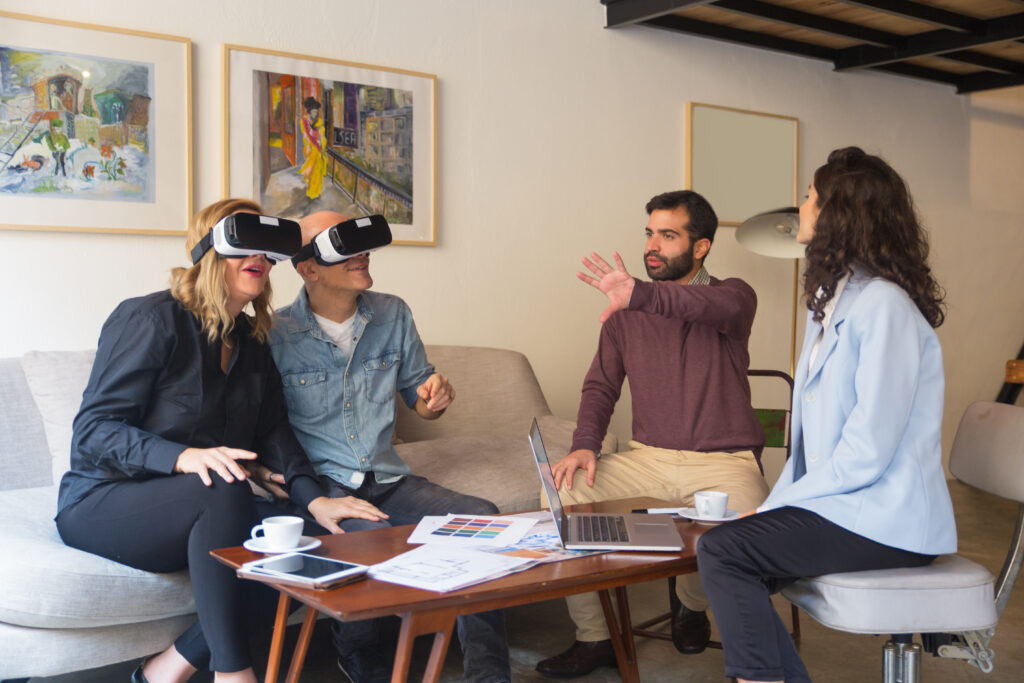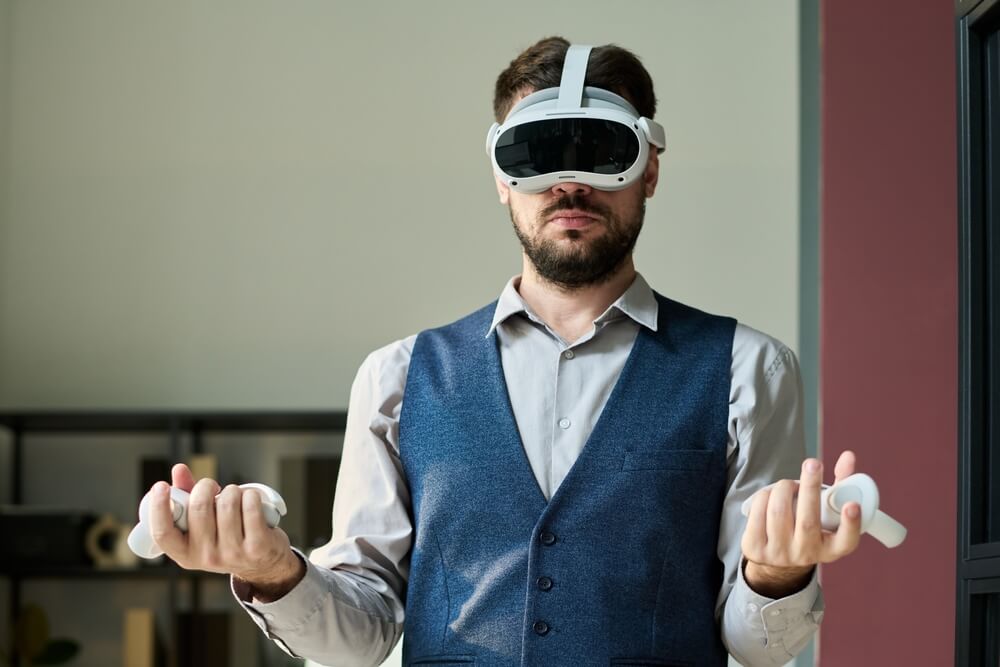Can VR technology help with the fight against chronic pain?
Table of Contents:
Did you know that pain management is a rapidly growing healthcare concern in the US? Currently, around 100 million adults in the country suffer from chronic pain and treating it is part of the daily routine of clinical anesthesiologists. However, most traditional methods aren’t fully effective. Some studies have shown that virtual reality could be a promising new approach that offers noninvasive therapy for chronic pain treatment. The latest technology may be effective in reducing chronic pain syndrome in both adults and children. Let’s dive deeper into the results already yielded in experimental and clinical studies and find out what the benefits of at-home virtual reality therapy for chronic pain are.
What is chronic pain?
In the US, over $17.8 billion is spent prescribing pain medication annually. In the past, opioid medications were most widely used for chronic pain treatment, but it was quickly noticed that these had too many negative side effects, including increased risk of permanent disability and a potential delay in recovery. Therefore, the need to come up with alternative methods for pain management has become urgent.
So, what actually is chronic pain syndrome? We all know that pain occurs when something hurts, causing an uncomfortable or unpleasant feeling. Simply put, there are two types of pain. One is acute pain, which comes on suddenly and is caused by something specific. It doesn’t usually last longer than 6 months. Causes of acute pain include surgery, dental work, burns or cuts, broken bones, labor, and childbirth etc. Then there is chronic pain. This is pain that is ongoing and lasts for a long time – months or even years.
Chronic pain can happen anywhere in the body. It can interfere with a person’s daily activities such as working, taking care of themselves or others, or having a social life. It may lead to depression, anxiety, and trouble sleeping, which usually makes the pain worse. Chronic pain can be caused by illnesses like arthritis or cancer, while injuries and diseases can cause changes to your body that leave you more sensitive to pain. Such changes stay in place even after you are healed from the original disease or injury. They can leave you with chronic pain syndrome. In some cases, chronic pain can also be psychogenic or psychosomatic. It is also possible to have several causes of pain overlap. The most common conditions related to this syndrome include headache, cancer, nerve pain, arthritis, back pain, and fibromyalgia. People with chronic pain often have permanently tensed muscles, a limited ability to move around, a lack of energy, or changes in appetite. All these issues can cause emotional effects like:
- depression,
- anger,
- anxiety,
- fear of re-injury.
Unfortunately, chronic pain treatment is still a huge challenge for medical specialists. It isn’t only associated with pain location and type of stimulus, but it is also correlated with a sufferer’s subjective and personal pain threshold. This is extremely hard to evaluate. This is why chronic pain treatment has become a critical worldwide health issue.
Currently, the most common method of fighting chronic pain syndrome is medication. For example, for nerve pain, anticonvulsants are used, while various other medications, such as antidepressants, corticosteroids, muscle relaxers, opioids and many more, are used to treat a range of conditions. Some people try cognitive-behavioral therapy or counseling, acupuncture, or biofeedback etc. But, just recently, it has been discovered that virtual reality could provide a real breakthrough in the treatment of chronic pain.
What is virtual reality?
Virtual Reality is an innovative, comprehensive technologically advanced system that allows users to be fully immersed in a virtual world. The user is engaged in a virtual experience through a combination of technologies. Usually, they use a head mounted display, a rumble pad, headphones with sound and noise reduction, joystick etc. These technologies allow them to move and interact with the virtual world. It’s entirely different from just watching a movie or playing a video game or game console. Nowadays, Virtual Reality is widely used in medicine and healthcare. It moved to clinical researchers and real-life medical practitioners.
VR is used in both patient education and surgeries – surgery is performed using a robotic device, e.g. robotic arm which is controlled by a human surgeon. Also, Virtual Reality’s ability to move a patient into the virtual world can be used to create powerful simulations of the scenarios in which psychological difficulties occur. Why not use Virtual Reality in chronic pain treatment then?
How can VR help patients suffering from chronic pain?
The research run at the Oasis Center for Natural Pain Management in Maryland came up with the thesis that ‘Virtual reality is an excellent approach to pain management. It captures the mind’s attention and blocks pain signals from reaching the brain. It’s almost like a form of active hypnosis. VR provides tactile and sensory feedback and allows the patient to rally the neurotransmitter mechanisms that decrease pain.’ And this is true. More and more studies have already investigated the potential of VR in chronic pain treatment. Unlike using medications and opioids that have numerous negative side effects (and on top of that, which may be addictive), VR is a safe way to support pain management. At-home virtual reality therapy doesn’t require any prescription and it can be used anytime, anywhere in the world. All you need is the hardware and an app. The technology is even more useful now, amid the Covid-19 pandemic.
How has VR been used in chronic pain treatment so far?
So far, virtual reality has been tested as a way to treat chronic pain. It has been proven that patients who were given VR headsets and watched virtual programs and played virtual games or explored a virtual world, saw a decrease in pain intensity and pain interference with activity and stress. Interestingly, patients with the most severe pain reported the greatest benefits from using the virtual reality headsets.
It has also been proven that virtual reality can help distract people from their pain – when patients are engaged in an immersive experience, they begin to tune out other stimuli, including their body’s pain signals. Therefore, VR programs are widely considered to be an effective and safe therapy for chronic pain treatment. They amplify the effectiveness of other forms of intervention.
How can VR change the way doctors and medical professionals deal with chronic pain?
Undoubtedly, virtual reality is a powerful weapon against various medical conditions. The technology helps patients with chronic pain syndrome; however, it is also highly beneficial for healthcare companies, doctors, physiotherapists, and medical professionals. One could say that when it comes to VR in the healthcare industry, the future is now. For example, progressive, multisession VR experiences that teach stress resilience and emotional regulation are already in use. These are linked to cloud platforms that direct the patients’ experiences throughout the experience, collecting data during each session.
Another application is VR telehealth kits for patients with chronic pain. These are usually easy-to-follow VR apps geared towards different conditions including chronic pain management, memory decline, physical therapy, and stress and anxiety. There are also VR products aimed at helping people with anxiety disorders and substance use disorders, including in clinical rehabilitation settings. A very popular at-home virtual reality therapy for chronic pain is an immersive 360-degree experience with calming, gentle music and visual imagery that helps the user feel relaxed. The software can monitor the user’s heart rate and modify the program to provide the most effective response.
Summary
Virtual reality has produced very promising results when it comes to chronic pain treatment. Even if VR solutions are still limited due to the cost and a reluctance to embrace technology or innovation, it has become more and more accessible to medical professionals and patients. It is extremely important to make the technology affordable for more medical centers – virtual reality options are non-addictive, portable, and non-invasive. At-home virtual reality therapy for chronic pain might be a real breakthrough that will revolutionize the medical industry.
Read also how Virtual Reality transforms the lives of disabled people?

Author: Rafał Siejca
Rafal has over twenty years of corporate experience, including roles at Millennium Bank, Comarch, and leading software teams at PZU, one of Europe’s largest insurance companies. As one of Poland’s few true VR experts with a decade of experience, he ensures timely, high-quality project delivery as CEO and CTO.










